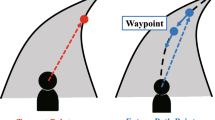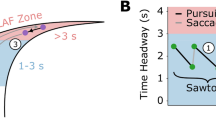Abstract
The gaze movement from a driver represents specific skills related to safe driving. Driving maneuvering evaluation is to know driving fitness. We found that gaze movement entropy is highly sensitive to visual behavior demands while driving a vehicle and the workload level. Entropy measures were more sensitive, more robust, and easier to calculate than gaze established measures. The gaze movement measures were collected using a driving simulator, using five different simulate routes and tree different workload scenarios; one route of familiarization was used to create a baseline. Because the workload became more difficult, drivers looked more at the central part of the road for more extended periods, the gaze movement entropy values decreased when the workload was increased, and the results show differences between two levels of workload. Also, the entropy result is compared against the classical analysis of the spatial distribution of gaze.
Access this chapter
Tax calculation will be finalised at checkout
Purchases are for personal use only
Similar content being viewed by others
References
Klauer, S.G., Dingus, T.A., Neale, V.L., Sudweeks, J., Ramsey, D. (2006). The Impact of Driver Inattention on Near-Crash/Crash Risk: An Analysis Using the 100-Car Naturalistic Driving Study Data (Technical Report No. DOT HS 810 594).: NHTSA. Washington DC
Engström, J.A., Johansson, E., Östlund, J.: Effects of visual and cognitive load in real and simulated motorway driving. Transp. Res. Part F 8, 97–120 (2005)
Pincus, S.M., Goldberger, A.L.: Physiological time series analysis: what does regularity quantify? American J. Physiol. (Heart. Circul. Physiol.) 266, H1643–H1656 (1994)
Shiferaw, B.A., Downey, L.A., Westlake, J., Stevens, B., Rajaratnam, S.M.W., Berlowitz, D.J., et al.: Stationary gaze entropy predicts lane departure events in sleep-deprived drivers. Sci. Rep. 8(1), 1–10 (2018)
Tole, J.R., Stephens, A.T., Vivaudou, M., Harris, R.L., Ephrath, A.R.: Entropy, Instrument Scan and Pilot Workload. IEEE, New York, NY, USA (1982)
Krejtz, K., Duchowski, A., Szmidt, T., Krejtz, I., González Perilli, F., Pires, A, et al.: Gaze transition entropy. ACM Trans. Appl. Percept TAP 13(1), 4:1–4:20 (2015)
Allsop, J., Gray, R.: Flying under pressure: effects of anxiety on attention and gaze behavior in aviation. J. Appl. Res. Memory Cognit. (2014). https://doi.org/10.1016/j.jarmac.2014.04.010
Underwood, G., Chapman, P., Brocklehurst, N., Underwood, J., Crundall, D.L Visual attention while driving: sequences of eye fixations made by experienced and novice drivers. Ergonomics 139 (2003)
Wang, Y., Bao, S., Du, W., Ye, Z., Sayer, J.R.: Examining drivers’ eye glance patterns during distracted driving: Insights from scanning randomness and glance transition matrix. J. Safety Res. 1(63), 149–155 (2017)
Mikula, L., et al.: Eye-head coordination and dynamic visual scanning as indicators of visuo-cognitive demands in driving simulator (2020). https://doi.org/10.1101/2020.09.23.309559
Michaels, J., et al.: Driving simulator scenarios and measures to faithfully evaluate risky driving behavior: a comparative study of different driver age groups. PLoS One 12, 1–24 (2017)
Victor, T., Harbluk, J.L., Engström, J.A.: Sensitivity of eye-movement measures to in-vehicle task difficulty. Transp. Res. Part F 8(2), 167–190 (2005)
Mejia-Romero S., et al.: An effective filtering process for the noise suppression in eye movement signals (2019a)
Mejia-Romero S., et al. “Dynamic performance of gaze movement, using spectral decomposition and phasor representation (2019b)
Acknowledgements
This research was partly funded by an NSERC Discovery grant and Essilor Industrial Research Chair (IRCPJ 305729-13), Research and development cooperative NSERC-Essilor Grant (CRDPJ 533187 - 2018), Prompt
Author Contribution
M-R.S. led the design of the research method and implemented the data analysis. M-R.S participated in preparing of the conclusions based on the results. MJ collected the raw data on how to work for his Ph.D. research. All authors took part in the paper preparation and edition.
Conflicts of Interest
The authors of this manuscript declare no conflict of interest. We express that the sponsors had no role in the design of the study, analysis, and writing of the manuscript and the decision to publish the results.
Author information
Authors and Affiliations
Corresponding author
Editor information
Editors and Affiliations
Rights and permissions
Copyright information
© 2021 The Author(s), under exclusive license to Springer Nature Singapore Pte Ltd.
About this paper
Cite this paper
Mejia-Romero, S., Michaels, J., Eduardo Lugo, J., Bernardin, D., Faubert, J. (2021). Gaze Movement’s Entropy Analysis to Detect Workload Levels. In: Kaiser, M.S., Bandyopadhyay, A., Mahmud, M., Ray, K. (eds) Proceedings of International Conference on Trends in Computational and Cognitive Engineering. Advances in Intelligent Systems and Computing, vol 1309. Springer, Singapore. https://doi.org/10.1007/978-981-33-4673-4_13
Download citation
DOI: https://doi.org/10.1007/978-981-33-4673-4_13
Published:
Publisher Name: Springer, Singapore
Print ISBN: 978-981-33-4672-7
Online ISBN: 978-981-33-4673-4
eBook Packages: Intelligent Technologies and RoboticsIntelligent Technologies and Robotics (R0)




